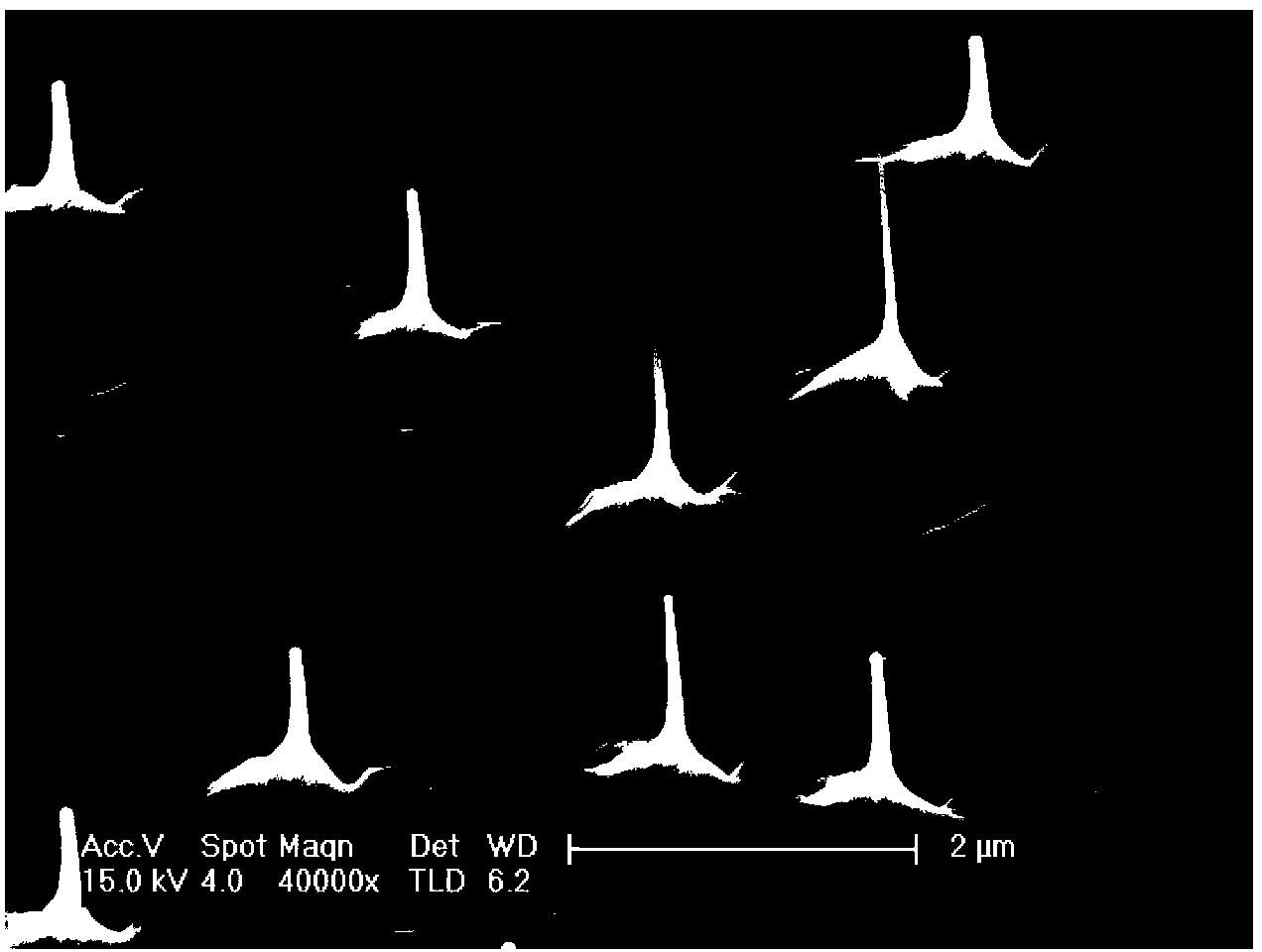Molecular beam epitaxial (MBE) growth method of Bi element regulated and controlled GaAs-based nanowire crystal structure
A molecular beam epitaxy, crystal structure technology, applied in the direction of crystal growth, single crystal growth, single crystal growth, etc., can solve problems such as unfavorable growth of long, short and uniform nanowires, affecting the performance uniformity of optoelectronic devices, and achieve the effect of excellent materials
- Summary
- Abstract
- Description
- Claims
- Application Information
AI Technical Summary
Problems solved by technology
Method used
Image
Examples
Embodiment 1
[0017] In this example, the storage furnace temperature of the As evaporation source is controlled at 180°C, the temperature of the Ga evaporation source is controlled at 950°C, and the temperature of the Bi evaporation source is controlled at 480°C, so that x=40%, the gold film will be plated and pretreated. The GaAs(111)B substrate was loaded into the MBE growth chamber, and the growth temperature was controlled at 420℃. After growing the GaAs nanowires for 10 minutes, under the condition that the growth conditions remain unchanged, open the Bi evaporation source baffle, introduce Bi element to reduce the ionic type of GaAs, so as to promote the formation of the sphalerite structure GaAs nanowires and growth After the completion of cooling the substrate and each evaporation source, the sample is transferred to the MBE pretreatment chamber to take out the GaAs nanowires with wurtzite structure and sphalerite structure coexisting. High-resolution transmission electron microscop...
Embodiment 2
[0019] In this example, the storage furnace temperature of the As evaporation source is controlled at 180°C, the temperature of the Ga evaporation source is controlled at 950°C, and the temperature of the Bi evaporation source is controlled at 500°C, so that x=66%, the gold film will be plated and pretreated. The GaAs(111)B substrate was loaded into the MBE growth chamber, and the growth temperature was controlled at 420℃. After growing the GaAs nanowires for 10 minutes, under the condition that the growth conditions remain unchanged, open the Bi evaporation source baffle, introduce Bi element to reduce the ionic type of GaAs, so as to promote the formation of the sphalerite structure GaAs nanowires and growth After the completion of cooling the substrate and each evaporation source, the sample is transferred to the MBE pretreatment chamber to take out the GaAs nanowires with wurtzite structure and sphalerite structure coexisting. High-resolution transmission electron microscop...
Embodiment 3
[0021] In this example, the storage furnace temperature of the As evaporation source is controlled at 180°C, the temperature of the Ga evaporation source is controlled at 940°C, and the temperature of the Bi evaporation source is controlled at 500°C, so that x=50%, the gold film will be plated and pretreated. The GaAs(111)B substrate was loaded into the MBE growth chamber, and the growth temperature was controlled at 420℃. After growing the GaAs nanowires for 10 minutes, under the condition that the growth conditions remain unchanged, open the Bi evaporation source baffle, introduce Bi element to reduce the ionic type of GaAs, so as to promote the formation of the sphalerite structure GaAs nanowires and growth After the completion of cooling the substrate and each evaporation source, the sample is transferred to the MBE pretreatment chamber to take out the GaAs nanowires with wurtzite structure and sphalerite structure coexisting. High-resolution transmission electron microscop...
PUM
| Property | Measurement | Unit |
|---|---|---|
| thickness | aaaaa | aaaaa |
Abstract
Description
Claims
Application Information
 Login to View More
Login to View More - R&D
- Intellectual Property
- Life Sciences
- Materials
- Tech Scout
- Unparalleled Data Quality
- Higher Quality Content
- 60% Fewer Hallucinations
Browse by: Latest US Patents, China's latest patents, Technical Efficacy Thesaurus, Application Domain, Technology Topic, Popular Technical Reports.
© 2025 PatSnap. All rights reserved.Legal|Privacy policy|Modern Slavery Act Transparency Statement|Sitemap|About US| Contact US: help@patsnap.com


